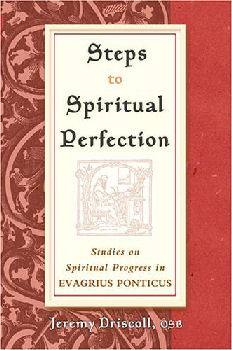
|
Posted March 28, 2006
Book: Steps to Spiritual Perfection: Studies on Spiritual Progress in Evagrius Ponticus Author: Jeremy Driscoll, OSB The Newman Press, Mahwah, New Jersey, 2005, pp. 185 An Excerpt from the Jacket:
The encounter with Evagrius here becomes for modern readers what it was for those to whom he first wrote: a way of receiving words from one of the desert maters too far distant for a live encounter. Evagrius’s words awaken new spiritual desires as he defines and helps the reader to understand one’s interior life. He sets out challenging conditions that are requirements for the spiritual goal – knowledge of the Holy Trinity in a luminous place of prayer. An Excerpt from the Book: To summarize: according to Evagrius, who let himself be firmly guide by the biblical text, love of money is the root of all evil. It agitates the irascible part of the soul and thus prevents love. Without this root pulled out, other passions will overtake the soul, making it increasingly difficult to establish love, which is the culmination of all the virtues. Without love, there is no passage to the knowledge of the Holy Trinity, the ultimate goal and final blessedness. This is the naked content of Evagrius’ teaching. But Evagrius does not deliver his content naked. He cloths it in striking images, for the most part drawn from the scriptures. Such images are not mere decoration but, under the practice of meditation, become part of the very content itself. Only the practice of such meditation can verify the forcefulness of this particular way of teaching. The rich man is like a camel attempting to go through the eye of a needle, an overloaded ship, a dog dragging a chain, a person filled with darkness. Perhaps the most forceful image of all is the one we can use to close this chapter. It is an image that makes clear the personal dimensions of the question of love of money and its christological perspective. It is an image that gains greater force for being rooted in the actual events of salvation history. With it Evagrius shows that each one of us, in deciding what he will do about money and riches, is involved in that same salvation history and must decide for himself into which of several patterns he will fall. “Judas the traitor received an intelligible richness and spiritual goods, but he did not know how to use them, because for the sake of gain, he betrayed the wisdom and truth of God.” Obviously Evagrius would expect each baptized Christian to see himself under this description of Judas before his fall. Each one has received intelligible richness and spiritual goods. This is nothing less than discipleship and friendship with Jesus. To seek material wealth instead of this — “Judas was a thief” — expressed as “the wisdom and truth of God.” It is obvious where wisdom lies. The time and context of Evagrius’s teaching — the fourth century, the Egyptian desert — are very much different from our own. Yet his is a wisdom that still calls out to us in our own time. As monasticism can do in any age when it is healthy, it wants to be a clear sign for the whole church of some of the fundamental issues of the Christian life. The work of creating a radically clear image is perhaps the particular vocation of the monastic life, but monastic life means to show what each Christian must incorporate into his or her own life. The monastic life of Evagrius’s time reminds all Christians in our time that loving money wrongly may be considered the very root of all evil. From it stems a host of other problems. The important thing is to use material goods for the building up of love and never to let desire for these impede our love and concern for others. Then the mind is free, as it was created to be, for loving contemplation and knowledge of the Holy Trinity. This is the true wealth. Nothing is sweeter, nothing more valuable. Table of Contents: 1. Spiritual progress in the works of Evagrius Ponticus 2. Spousal images 3. Penthos and tears 4. The evil thought “love of money” 5. Apatheia and purity of heart 6. Evagrius and Paphnutius on the causes for abondonment of God 7. Exegetical procedures in the Desert Monk Poemen 8. The Fathers of Poemen and the Evagrian connection Conclusion |
|
